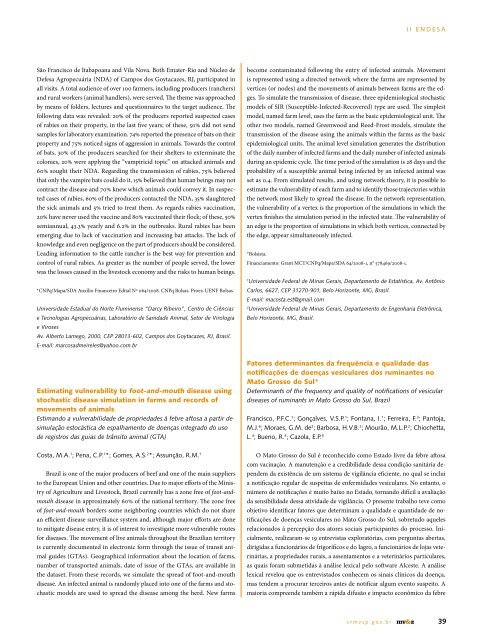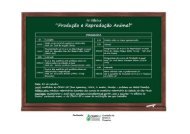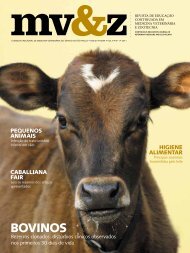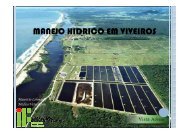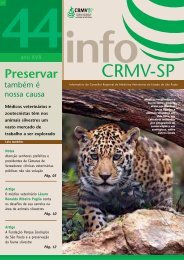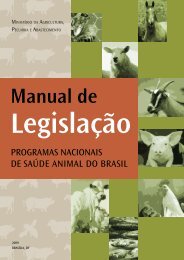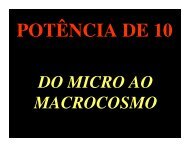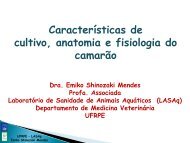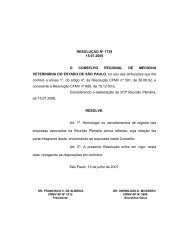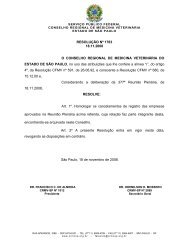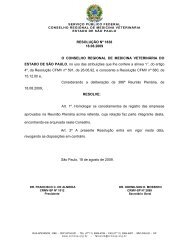I I e n d e s aA Vaccinia bovina (VB), zoonose emergente, causada pelo Vaccinia virus(VACV) é caracterizada pelo surgimento de lesões ulceradas no teto das vacasem lactação e nas mãos e braços de ordenhadores. A partir da década de 1990,o número de casos de VB vem crescendo, sendo hoje identificados surtos emquase todos os estados brasileiros. A doença é subnotificada e as medidas decontenção necessárias para o seu controle são frequentemente desconhecidas,favorecendo a disseminação da doença. Os pre juízos econômicos relacionadosà VB estão associados principalmente à queda brusca na produção do leite,presença de infecções secundárias e aumento dos gastos com medicamentos.Estudos prévios revelaram a presença tanto de DNA, quanto de partículas viraisinfecciosas do VACV, no leite de vacas doentes em surtos de VB em MinasGerais, chamando a atenção para o potencial risco à saúde pública. Porém,permanecem desconhecidos o perfil de eliminação do vírus no leite de vacasacometidas e a origem das partículas virais presentes no leite. Este trabalho objetivoupesquisar a presença do DNA viral através da técnica de PCR, em leitede animais experimentalmente infectados, e de estabelecer o período e o perfilde eliminação do vírus no leite. Oito vacas mes tiças em lactação, soronegativaspara o VACV, foram inoculadas com VACV, amostra GP-2 (isolada de surto deVB ocorrido no município de Guarani, MG), na concentração de 106 PFU/50μL.Os tetos foram escarificados com lixa, sendo que o teto posterior esquerdo(TPE) de cada vaca não foi inoculado, servindo de controle negativo. Amostrasde leite foram coletadas durante 32 dias ininterruptos e alternados até o 60ºdia, sendo os dias pares coletados com uma sonda estéril e os dias ímparesatravés de ordenha manual. Todas as amostras foram submetidas à PCR parao gene vgf. Entre o segundo e o quarto dia pós-infecção (DPI), todos os tetos,com exceção do TPE, apresentaram lesões típicas de VB que cicatrizaram emmédia após 21 dias. Foi possível detectar a presença de DNA viral no leite apartir do terceiro DPI e, de forma intermitente, até o sexagésimo dia. O leitederivado dos tetos inoculados do controle (TPE), de todas as oito vacas, apresentaram,em algum momento, DNA viral. Além disso, indiferentemente daforma de coleta (manual ou com sonda), foi possível detectar o DNA viral noleite. Esses resultados mostram que o vírus pode ser eliminado de forma intermitenteno leite durante e após a fase aguda da doença, mesmo após a cicatrizaçãototal das lesões, sugerindo uma possível infecção sistêmica e persistente.Financiamento: CNPq/Mapa, Fapemig, Capes.(VACV), which affects dairy cattle and milkers. In bovine natural infections,it seems that BV is a localized disease, with cutaneous lesions restricted to theteats. However, there are no studies about experimental infection with VACVin bovines to establish its pathogenesis and elimination pathways. The aim ofthis study was to study the occurrence of viremia and elimination of VACV inbovine feces. Eight crossbred lactating cows, serologically negative for VACV,were used. Teats were previously scarified with sand paper and then inoculatedwith 106 pfu/100 μL of Guarani P2 (GP2) strain of VACV. Blood samples andfeces were collected daily throughout the experi ment. After 66 days post inoculation(d.p.i) the animals were divided into two groups that receive two newdifferent treatments. One group was re-inoculated with the same inoculumand the other was subjected to chemical immunosuppression, to evaluate whetherre-infected animals and/or experimentally infected animals that recoverfrom previous lesions in conditions of immu nosuppression could eliminateVACV on feces once more. Animals from both groups were monitored for upthe 89th day post initial inoculation. Viral DNA was continuously detectedand quantified in blood and feces of these animals in an intermittent way, evenafter the resolution of the lesions. At slaughter, tissues were collected and theviral DNA was detected and quantified from mesenteric and retro mammarylymph nodes, ileum, spleen and liver. The detection of VACV DNA in bloodand feces for long period and its detection in lymphatic organs provide newevidence about VACV elimination and suggest, for the first time, that BV couldbe a persistent systemic infection.Financial support: CNPq/Mapa, Fapemig, Capes.1Universidade Federal de Minas Gerais, Escola de Vete rinária, Departamento deMedicina Veterinária Preventiva,Laboratório de Pesquisa em Virologia AnimalAv. Antônio Carlos, 6.627, CEP 31270-901,Belo Horizonte, MG, Brasil.E-mail: ziplobato@gmail.com2Universidade Federal de Minas Gerais, Instituto de Ciências Biológicas,Departamento de Microbiologia, Laboratório de Vírus, Belo Horizonte, MG,Brasil.1Universidade Federal de Minas Gerais, Escola de Veterinária, Departamento deMedicina Veterinária Preventiva, Laboratório de Pesquisa em Virologia Animal,Av. Antônio Carlos, 6.627, CEP 31270-901, Belo Horizonte, MG, Brasil.E-mail: ziplobato@gmail.com2Universidade Federal de Minas Gerais, Instituto de Ciências Biológicas,Departamento de Microbiologia, Laboratório de Vírus, Belo Horizonte, MG,Brasil.Bovine vaccinia, a sistemic infection: evidence of fecalshedding, viremia and detection in lymphoid organsVaccínia bovina, uma infecção sistêmica: evidencia de eliminação nasfezes, viremia e detecção do vírus em órgãos linfóidesRivetti Junior, A.V. 1 ; Guedes, M.I.M.C. 1 ; Oliveira, T.M.L. De 1 ; Rehfeld,I.S. 1 ; Matos, A.C.D. 1 ; Rodrigues, N.F.S. 1 ; Abrahão, J.S. 2 ; Kroon, E.G. 2 ;Lobato, Z.I.P. 1Bovine vaccinia (BV) is an occupational zoonosis caused by Vaccinia virusSimplifying science and technology to clarify and ask therancher from Rio de Janeiro state everything about ruralrabies*Descomplicando a ciência e a tecnologia para esclarecer e perguntar aopecuarista fluminense tudo sobre a raiva ruralMeireles, m.a.d.; Pereira, s.r.f.g.; Bernardo-Pedro, T.; Florido, V.A.;Oliveira, A.C.; Linhares, J.M.; Vieira, L.F.P.; Chicarino, C.N.Rabies is a contagious disease of great interest to the livestock and publichealth. The etiologic agent is a neurotropic virus (family Rhabdoviridae andgenus Lyssavirus), which affects the central nervous system. The disease hasan anthropozoonotic character, and all mammals may be infected and developit. Rabies affects domestic herbivores (livestock), and its main transmitter, inrural areas, is the “common vampire bat”, Desmodus rotundus. This researchaimed at education in health and surveillance of rabies, in a simple and playful,to the cattle ranchers of the Northern and Northwestern regions of Rio de JaneiroState, clarifying aspects about rural rabies. The following municipalities/locations were visited: Batatal, Boa Vista, Cardoso Moreira, Caxeta, Dores deMacabu, Espírito Santinho, Hatobá, Italiana, Italva, Pedra Santa, Santa Maria,38 mv&z c r m v s p . g o v . b r
I I e n d e s aSão Francisco de Itabapoana and Vila Nova. Both Emater-Rio and Núcleo deDefesa Agropecuária (NDA) of Campos dos Goytacazes, RJ, participated inall visits. A total audience of over 100 farmers, including producers (ranchers)and rural workers (animal handlers), were served. The theme was approachedby means of folders, lectures and questionnaires to the target audience. Thefollowing data was revealed: 20% of the producers reported suspected casesof rabies on their property, in the last five years; of these, 50% did not sendsamples for laboratory examination. 74% reported the presence of bats on theirproperty and 75% noticed signs of aggression in animals. Towards the controlof bats, 30% of the producers searched for their shelters to exterminate thecolonies, 20% were applying the “vampiricid topic” on attacked animals and60% sought their NDA. Regarding the transmission of rabies, 75% believedthat only the vampire bats could do it, 15% believed that human beings may notcontract the disease and 70% knew which animals could convey it. In suspectedcases of rabies, 60% of the producers contacted the NDA, 35% slaughteredthe sick animals and 5% tried to treat them. As regards rabies vaccination,20% have never used the vaccine and 80% vaccinated their flock; of these, 50%semiannual, 43.3% yearly and 6.2% in the outbreaks. Rural rabies has beenemerging due to lack of vaccination and increasing bat attacks. The lack ofknowledge and even negligence on the part of producers should be considered.Leading information to the cattle rancher is the best way for prevention andcontrol of rural rabies. As greater as the number of people served, the lowerwas the losses caused in the livestock economy and the risks to human beings.*CNPq/Mapa/SDA Auxílio Financeiro Edital Nº 064/2008. CNPq Bolsas. Proex-UENF Bolsas.Universidade Estadual do Norte Fluminense “Darcy Ribei ro”, Centro de Ciênciase Tecnologias Agropecuárias, Laboratório de Sanidade Animal, Setor de Virologiae VirosesAv. Alberto Lamego, 2000, CEP 28013-602, Campos dos Goytacazes, RJ, Brasil.E-mail: marcosadmeireles@yahoo.com.brbecome contaminated following the entry of infected animals. Movementis represented using a directed network where the farms are represented byvertices (or nodes) and the movements of animals between farms are the edges.To simulate the transmission of disease, three epidemiological stochasticmodels of SIR (Susceptible-Infected-Recovered) type are used. The simplestmodel, named farm level, uses the farm as the basic epidemiological unit. Theother two models, named Greenwood and Reed-Frost models, simulate thetransmission of the disease using the animals within the farms as the basicepidemiological units. The animal level simulation generates the distributionof the daily number of infected farms and the daily number of infected animalsduring an epidemic cycle. The time period of the simulation is 28 days and theprobability of a susceptible animal being infected by an infected animal wasset as 0.4. From simulated results, and using network theory, it is possible toestimate the vulnerability of each farm and to identify those trajectories withinthe network most likely to spread the disease. In the network representation,the vulnerability of a vertex is the proportion of the simulations in which thevertex finishes the simulation period in the infected state. The vulnerability ofan edge is the proportion of simulations in which both vertices, connected bythe edge, appear simultaneously infected.*Bolsista.Financiamento: Grant MCT/CNPq/Mapa/SDA 64/2008-1, n° 578469/2008-1.1Universidade Federal de Minas Gerais, Departamento de Estatística, Av. AntônioCarlos, 6627, CEP 31270-901, Belo Horizonte, MG, Brasil.E-mail: macosta.est@gmail.com2Universidade Federal de Minas Gerais, Departamento de Engenharia Eletrônica,Belo Horizonte, MG, Brasil.Estimating vulnerability to foot-and-mouth disease usingstochastic disease simulation in farms and records ofmovements of animalsEstimando a vulnerabilidade de propriedades à febre aftosa a partir desimulação estocástica de espalhamento de doenças integrado do usode registros das guias de trânsito animal (GTA)Costa, M.A. 1 ; Pena, C.P. 1 *; Gomes, A.S. 2 *; Assunção, R.M. 1Brazil is one of the major producers of beef and one of the main suppliersto the European Union and other countries. Due to major efforts of the Ministryof Agriculture and Livestock, Brazil currently has a zone free of foot-andmouthdisease in approxi mately 60% of the national territory. The zone freeof foot-and-mouth borders some neighboring countries which do not sharean efficient disease surveillance system and, although major efforts are doneto mitigate disease entry, it is of interest to investigate more vulnerable routesfor diseases. The movement of live animals throughout the Brazilian territoryis currently documented in electronic form through the issue of transit animalguides (GTAs). Geographical information about the location of farms,number of transported animals, date of issue of the GTAs, are available inthe dataset. From these records, we simulate the spread of foot -and-mouthdisease. An infected animal is randomly placed into one of the farms and stochasticmodels are used to spread the disease among the herd. New farmsFatores determinantes da frequência e qualidade dasnotificações de doenças vesiculares dos ruminantes noMato Grosso do Sul*Determinants of the frequency and quality of notifications of vesiculardiseases of ruminants in Mato Grosso do Sul, BrazilFrancisco, P.F.C. 1 ; Gonçalves, V.S.P. 1 ; Fontana, I. 1 ; Ferreira, F. 3 ; Pantoja,M.J. 6 ; Moraes, G.M. de 2 ; Barbosa, H.V.B. 2 ; Mourão, M.L.P. 2 ; Chiochetta,L. 4 ; Bueno, R. 4 ; Cazola, E.P. 5O Mato Grosso do Sul é reconhecido como Estado livre da febre aftosacom vacinação. A manutenção e a credibilidade dessa condição sanitária dependemda existência de um sistema de vigilância eficiente, no qual se incluia notificação regular de sus peitas de enfermidades vesiculares. No entanto, onúmero de notificações é muito baixo no Estado, tornando difícil a avaliaçãoda sensibilidade dessa atividade de vigilância. O presente trabalho teve comoobjetivo identificar fatores que determinam a qua lidade e quantidade de notificaçõesde doenças vesiculares no Mato Grosso do Sul, sobretudo aquelesrelacionados à percepção dos atores sociais participantes do processo. Inicialmente,realizaram-se 19 entrevistas exploratórias, com perguntas abertas,dirigidas a funcionários de frigoríficos e do Iagro, a funcionários de lojas veterinárias,a propriedades rurais, a assentamentos e a veterinários particulares,as quais foram submetidas à análise lexical pelo software Alceste. A análiselexical revelou que os entrevistados conhecem os sinais clínicos da doença,mas tendem a procurar terceiros antes de notificar algum evento suspeito. Amaioria compreende também a rápida difusão e impacto econômico da febrec r m v s p . g o v . b rmv&z39
- Page 1 and 2: mv&zCONSELHO REGIONAL DE MEDICINA V
- Page 3 and 4: E X L I B R I SC R M V - S Pc r m v
- Page 5 and 6: E D I T O R I A LColega,Fale conosc
- Page 9 and 10: g r a n d e s a n i m a i sMaterial
- Page 11 and 12: g r a n d e s a n i m a i sOs resul
- Page 13 and 14: g r a n d e s a n i m a i snostico
- Page 15 and 16: Pedro Vieira Borges Salgueiro 1 sal
- Page 17 and 18: h i g i e n e a l i m e n t a rquan
- Page 19 and 20: h i g i e n e a l i m e n t a rfaci
- Page 21 and 22: Flávia MoratoCássia Yumi IkutaFum
- Page 23 and 24: z o o n o s e santigo datado de 182
- Page 25 and 26: z o o n o s e sNa Austrália, o ví
- Page 27 and 28: z o o n o s e sos genótipos 2 e 3.
- Page 29 and 30: z o o n o s e s45. PATHINFO (Pathog
- Page 31: I I e n d e s aII ENDESAc r m v s p
- Page 36 and 37: I I e n d e s aque as proteínas pu
- Page 40 and 41: I I e n d e s aaftosa. Os pecuarist
- Page 42 and 43: I I e n d e s aaté a sétima passa
- Page 44 and 45: I I e n d e s a1Instituto “Evandr
- Page 46 and 47: I I e n d e s aequinos sensibilizad
- Page 48 and 49: I I e n d e s aA mastite é um entr
- Page 50 and 51: I I e n d e s anos animais vacinado
- Page 52 and 53: I I e n d e s acom menos de 30 fêm
- Page 54 and 55: I I e n d e s aCardoso, D. L. 1 ; V
- Page 56 and 57: I I e n d e s aMercury, lead, arsen
- Page 58 and 59: I I e n d e s afoi avaliar a presen
- Page 60 and 61: I I e n d e s adois pontos abaixo n
- Page 62 and 63: I I e n d e s aaquáticos. Tais est
- Page 64 and 65: I I e n d e s aE-mail: giovanacamil
- Page 66 and 67: I I e n d e s a1Empresa de Pesquisa
- Page 68 and 69: I I e n d e s aSpectrophotometric d
- Page 70 and 71: I I e n d e s apublicações detalh
- Page 72 and 73: I I e n d e s aa partir de modelos
- Page 74 and 75: I I e n d e s aVigilância da sanid
- Page 76 and 77: I I e n d e s asistema, essas respe
- Page 78 and 79: x i i c o n f e r ê n c i a78 mv&z
- Page 80 and 81: x i i c o n f e r ê n c i aMCCUE,
- Page 82 and 83: x i i c o n f e r ê n c i aFigura
- Page 84 and 85: x i i c o n f e r ê n c i aSMITH,
- Page 86 and 87: x i i c o n f e r ê n c i aprogram
- Page 88 and 89:
x i i c o n f e r ê n c i aSMITH,
- Page 90 and 91:
x i i c o n f e r ê n c i apossive
- Page 92 and 93:
x i i c o n f e r ê n c i aapenas
- Page 94 and 95:
x i i c o n f e r ê n c i aMCCUE,
- Page 96 and 97:
x i i c o n f e r ê n c i aGrau Co
- Page 98 and 99:
x i i c o n f e r ê n c i adiscord


